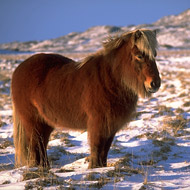
DNA sequencing reveals endemic strain of bacteria
The likely cause of a mystery epidemic which affected Iceland’s native horse population has been identified in a new study.
In 2010, a respiratory disease spread rapidly through Iceland’s population of 77,000 Icelandic horses, leading to a self-imposed ban on their export and significant cost to the country.
Due to the speed at which the disease spread, researchers thought the cause was viral. However, a study by the University of Iceland showed that only Streptococcus zooepidemicus, was consistently recovered from coughing horses and rare fatal cases of infection. However, this bacteria can also be found in healthy horses.
To investigate further, researchers at the AHT and the Wellcome Trust Sanger Institute sequenced the DNA from 257 samples of bacteria from diseased animals and people. This revealed one specific strain of S. zooepidemicus, called ST209, was the likely culprit. Researchers also found the strain in a human case of blood poisoning.
“This study highlights, for the first time, how DNA sequencing can be used to identify endemic strains of bacteria and distinguish them from the cause of an epidemic infection,” said Dr Simon Harris form the Wellcome Trust Sanger Institute.
Thanks to a ban on the importation of horses in 1882, Iceland is free of major equine infectious diseases. As such, Icelandic horses are highly susceptible to any new bacteria or viruses that find their way into the country, so strict biosecurity regulations are in place to protect them.
When the disease entered Iceland in 2010, it spread through the horse population in weeks and even managed to infect dogs, cats and humans.
Dr Sigríður Björnsdóttir of the MAST Icelandic Food and Veterinary Authority used information from owners and vets to build an epidemiological network. This enabled her to trace the virus back to an equine rehabilitation centre where the horses exercised on a water treadmill.
It is thought that the water treadmill provided the perfect breeding ground for the disease, allowing it to be transmitted to another animal as water was splashed up and ingested. Horses would then complete their rehabilitation and return home, whilst incubating the disease, taking the infection with them.
There are a couple of theories as to how the ST209 entered Iceland. The AHT believes the most likely route was via imported equipment or clothing. However, researchers say this particular strain could have infected a human who travelled to Iceland.
“We are delighted to have helped uncover the likely identity of the cause of this epidemic. Our investigation highlights the ability of S. zooepidemicus strains to cause disease in animals and people,” commented Dr Andrew Waller, head of bacteriology at the AHT.
“We found evidence that even endemic strains of S. zooepidemicus were likely causing cases of respiratory disease in Icelandic horses, illustrating that this group of bacteria causes more clinical problems in horses than was previously thought.”
He added: “We hope that raising awareness of the cause of this epidemic, and the likely involvement of a water treadmill as a key factor in disease transmission, will encourage veterinarians around the world to improve disease control precautions preventing future epidemics.”
Image (C) Andreas Tille.



 BSAVA is to partner with BVA Live (11-12 June 2026) to champion clinical research.
BSAVA is to partner with BVA Live (11-12 June 2026) to champion clinical research.